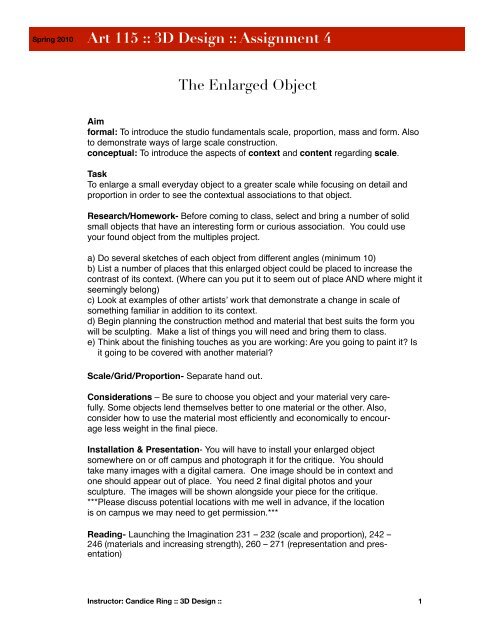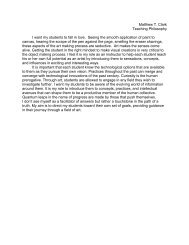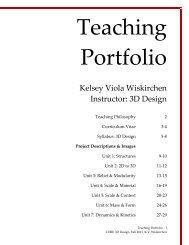3D Design Assignment 4-The Enlarged Object - artCORE
3D Design Assignment 4-The Enlarged Object - artCORE
3D Design Assignment 4-The Enlarged Object - artCORE
You also want an ePaper? Increase the reach of your titles
YUMPU automatically turns print PDFs into web optimized ePapers that Google loves.
Spring 2010<br />
Art 115 :: <strong>3D</strong> <strong>Design</strong> :: <strong>Assignment</strong> 4<br />
<strong>The</strong> <strong>Enlarged</strong> <strong>Object</strong><br />
Aim<br />
formal: To introduce the studio fundamentals scale, proportion, mass and form. Also<br />
to demonstrate ways of large scale construction.<br />
conceptual: To introduce the aspects of context and content regarding scale. <br />
Task<br />
To enlarge a small everyday object to a greater scale while focusing on detail and<br />
proportion in order to see the contextual associations to that object.<br />
Research/Homework- Before coming to class, select and bring a number of solid<br />
small objects that have an interesting form or curious association. You could use<br />
your found object from the multiples project.<br />
a) Do several sketches of each object from different angles (minimum 10)<br />
b) List a number of places that this enlarged object could be placed to increase the<br />
contrast of its context. (Where can you put it to seem out of place AND where might it<br />
seemingly belong)<br />
c) Look at examples of other artistsʼ work that demonstrate a change in scale of<br />
something familiar in addition to its context.<br />
d) Begin planning the construction method and material that best suits the form you<br />
will be sculpting. Make a list of things you will need and bring them to class.<br />
e) Think about the finishing touches as you are working: Are you going to paint it? Is<br />
it going to be covered with another material?<br />
Scale/Grid/Proportion- Separate hand out.<br />
Considerations – Be sure to choose you object and your material very carefully.<br />
Some objects lend themselves better to one material or the other. Also,<br />
consider how to use the material most efficiently and economically to encourage<br />
less weight in the final piece.<br />
Installation & Presentation- You will have to install your enlarged object<br />
somewhere on or off campus and photograph it for the critique. You should<br />
take many images with a digital camera. One image should be in context and<br />
one should appear out of place. You need 2 final digital photos and your<br />
sculpture. <strong>The</strong> images will be shown alongside your piece for the critique.<br />
***Please discuss potential locations with me well in advance, if the location<br />
is on campus we may need to get permission.***<br />
Reading- Launching the Imagination 231 – 232 (scale and proportion), 242 –<br />
246 (materials and increasing strength), 260 – 271 (representation and presentation)<br />
Instructor: Candice Ring :: <strong>3D</strong> <strong>Design</strong> :: 1
Spring 2010<br />
Art 115 :: <strong>3D</strong> <strong>Design</strong> :: <strong>Assignment</strong> 4<br />
Vocabulary<br />
scale, proportion, form, mass, visual weight, volume<br />
Artists to Reference<br />
Claes Oldenburg, Jeff Koons, Charles Ray, Ron Mueck, Paul McCarthy<br />
Assessment<br />
Technical<br />
Skill with material, satisfaction of problem requirements, craftsmanship, quality<br />
Work Process<br />
Evidence of reworking, research, processing of feedback, self critique, understanding<br />
context of assignment, sketches, sources, discussion, questioning<br />
Conceptual<br />
Invention, comprehension of ideas presented in project, communication of<br />
those ideas in the work and your intent, rational for object selection, content<br />
Ambition and Innovation<br />
Character or individual personality, impact of the work, expression, formal<br />
structure, content<br />
Finished Work & Critique<br />
Meets requirements outlined in the assignment, constructive participation,<br />
explanation of work, vocabulary<br />
Work Ethic<br />
Class attendance, participation in discussions, use of class time<br />
Project Value: 15%<br />
10% for <strong>Object</strong> Enlargement (sculpture)<br />
5% for photos of work in context<br />
Tentative Schedule<br />
March 10 Intro to <strong>Assignment</strong><br />
March 15 &17 Spring Break<br />
March 22 & 24 Studio time<br />
March 29 Critique of <strong>The</strong> <strong>Enlarged</strong> <strong>Object</strong> (Be ready to start at the <br />
beginning of class)<br />
Instructor: Candice Ring :: <strong>3D</strong> <strong>Design</strong> :: 2
Spring 2010<br />
Art 115 :: <strong>3D</strong> <strong>Design</strong> :: <strong>Assignment</strong> 4<br />
Notes on Scale<br />
Discussion: When studying scale in two-dimensional art, we distinguish between<br />
size and scale. Size is meaningful only in terms of how big an object is in relationship<br />
to something else (e.g., "something is bigger than a bread box..."). Once we<br />
measure something, we can play with its scale. Scale is generally understood as an<br />
object's size in relationship to a system of measurement. When we speak of things<br />
as being large or small in scale, we are referring to the size of an object in relationship<br />
with a clear set of measurements. For example, if you tell me that the shoes you<br />
just drew are "half scale," I would assume that they were half the measured length of<br />
the actual object--that is, one-half "full" or "actual size."<br />
When we move into some of the design professions, like architecture or industrial<br />
design for instance, other conventions apply. For example, if I said I want a drawing<br />
in "1/4 scale", generally I mean that I want a drawing in which "1/4 inch equals 1<br />
foot." In this case, instead of measuring the actual object against a system of measurement,<br />
we are relating two sets of measurements.<br />
Proportion refers to the ratio between the parts of a larger whole. If we go back to<br />
the shoe example, a drawing--at virtually any scale--that represented the shoes in<br />
"correct" proportion would show the actual relationship of height, width, and depth. I<br />
could alter the scale of the object without changing the proportions. Or, if I wanted to<br />
exaggerate the proportions (like a circus clown might do), I might make the length of<br />
the shoes twice the length of the original shoe and preserve the height and the width.<br />
In so doing, I have changed the proportions of the object--that is, I have changed the<br />
ratio of the parts describing the whole. If the original ratio of height, width, and depth<br />
could be represented by the following expression: 1:1:1, the new clown shoes could<br />
be represented by 1:1:2, where the 2 represents the new exaggerated depth (or<br />
length).<br />
A grid is a system of fixed horizontal and vertical divisions. Anything, no matter how<br />
complicated or irregularly shaped, can be conceived of in terms of X (horizontal) and<br />
Y (vertical) axes. <strong>The</strong> mechanical regularity of a grid can be useful in determining<br />
relationships between the parts of a painting or other graphic work (a map for instan<br />
ce). A grid can also be a useful tool for translating a given image from one scale to<br />
another or altering the proportions of an image.<br />
Sometimes scaling operations in <strong>3D</strong> are represented by changes in percent of the X,<br />
Y or Z axes. For example, imagine a drawing of the outline of a house in which the<br />
height, width, and depth each equal 100%. If you were to change the X axis to 25%,<br />
the house would be 1/4 its original width. If you were to change the Y axis (vertical)<br />
to 200% of its original size, the house would be twice as tall. By changing the X, Y<br />
and Z axes, you could transform the house into a completely different looking one.<br />
Instructor: Candice Ring :: <strong>3D</strong> <strong>Design</strong> :: 3
Spring 2010<br />
Art 115 :: <strong>3D</strong> <strong>Design</strong> :: <strong>Assignment</strong> 4<br />
<strong>The</strong> "house to tower" example above makes it clear that you needn't scale the X, Y,<br />
and Z axes equally--however, in so doing you alter the "meaning" of the object.<br />
We do not need to change the proportions of an object to change its meaning. By<br />
simply changing the scale of an object (maintaining its 1:1:1 ratio), we can radically<br />
alter its meaning and expressive power. <strong>The</strong> American artist, Claes Oldenburg,<br />
scales up everyday objects. In addition to creating representational enlargements of<br />
objects, he changes their functions by placing them in unexpected contexts. <strong>The</strong><br />
context of an object is the physical and cultural circumstances in which an object is<br />
situated. Our understanding of the meaning of a work is largely a result of seeing the<br />
work "in context"--that is, in understanding the relationship of the object to its surrounding<br />
circumstances. Once we take a work out of context, meanings can change<br />
and different situations or commentary can occur.<br />
Instructor: Candice Ring :: <strong>3D</strong> <strong>Design</strong> :: 4




